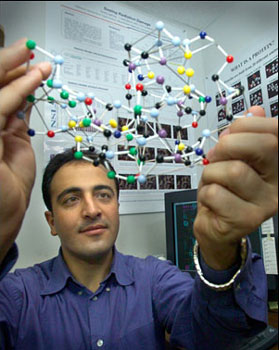National Synchrotron Light Source visiting scientist Mehmet Aslantas has won the prestigious Margaret C. Etter Student Lecturer Award for a talk on his recent work: how to reduce the effects of radiation damage to protein crystals during synchrotron x-ray studies.
He received the award at American Crystallographic Association national meeting, held in Chicago, Illinois, on July 18-22. The Etter award, given out just once a year, recognizes achievement and future potential for scientists at an early stage in their independent careers.
Aslantas, who initially came to the NSLS for six months through a U.S. Department of Energy Cooperative Research program, received an extension that allowed him to stay for over a year. “The NSLS is a great place to work, and I couldn’t have completed my research or won this award without the research extension I received,” said Aslantas. “I would like to thank the NSLS Chairman, Steve Dierker, the Associate Chair for User Science, Chi-Chang Kao, Vivian Stojanoff, and the User Administration office for their support.”

Aslantas worked under Stojanoff’s supervision at NSLS beamlines X6A and X17B1. In his talk, titled “Radiation Effects on Biological Samples,” he described his work at the beamlines. At X6A, he studied the effect of low-energy x-rays on “Lyzozyme” crystals, which are standard test protein crystals. At X17B1, the sample was subjected to high-energy x-rays.
“My experimental results show that, with lower-energy x-rays, the sample absorbs more radiation than at higher energies, in which it absorbs less energy and sustains no significant damage,” he said. “This is because the low-energy x-ray beam interacts with the inner shell electrons in the atoms of the protein, causing an overall higher dose to the sample. This leads to structural damage and limits the structural information we can learn about the sample. However the high energy x-rays interact with the outer shell electrons in the atom of the protein. This interaction, known as Compton Scattering, plays a role in causing the overall dose deposited to the sample to be less significant. The sample will have a longer life time, too.”
Currently, Aslantas is preparing three manuscripts describing his work at the NSLS. His experience will help him form a protein crystallography group at his home institution, Hacettepe University in Ankara, Turkey. In turn, this group will be working with SESAME to develop a protein crystallography beamline at the facility. After his return to Hacettepe University, Aslantas expects to keep in close contact with the NSLS and will continue his research.Aslantas’ work is funded by a U.S. Department of Energy Cooperative Research program, which allows him to work at the NSLS as part of a scientific exchange program with another synchrotron, SESAME (Synchrotron-light for Experimental Science and Applications in the Middle East). SESAME is under construction.
Article by: Laura Mgrdichian

